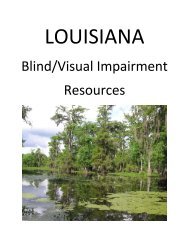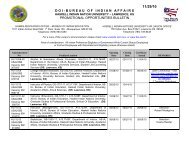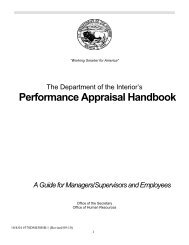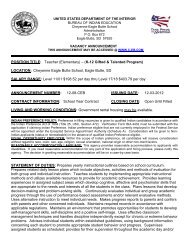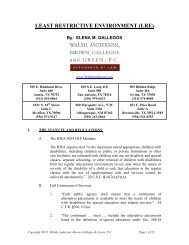communities. Schools range in size from eight to more than 1,100 students, representing over 240 Tribes with differentcultural backgrounds and on 64 reservations.The <strong>BIE</strong>'s school system is designed to meet the Federal government's commitment to provide for the education <strong>of</strong> theAmerican Indian/Alaskan Native children as called for in numerous treaties, court decisions, and legislation. AchievingAYP is one <strong>of</strong> the cornerstones <strong>of</strong> the Federal NCLB. In FY 2005, the <strong>BIE</strong> implemented several provisions required in NCLBthat were developed through a successfully negotiated rulemaking process in 2004 with Indian tribal leaders. One <strong>of</strong>these provisions addresses AYP standards for student achievement. Consensus was reached that <strong>BIE</strong> schools would usethe same AYP standards as the state within which they are located. Application <strong>of</strong> this methodology allows <strong>BIE</strong> to trackstudent academic pr<strong>of</strong>iciency in each <strong>of</strong> the <strong>BIE</strong>‐funded elementary and secondary schools relative to local public schoolperformance.THE <strong>NWEA</strong>-<strong>BIE</strong> PROJECT<strong>NWEA</strong> is a not-for-pr<strong>of</strong>it organization located in Portland, Oregon with <strong>of</strong>ferings in computer-adaptive assessment,research, pr<strong>of</strong>essional development, and reporting. <strong>NWEA</strong>’s Measures <strong>of</strong> Academic Progress (MAP) assessments arealigned to state standards and can predict pr<strong>of</strong>iciency on state exams. 112 <strong>BIE</strong> schools in 17 states use MAP assessmentsto inform instruction and predict pr<strong>of</strong>iciency on state tests.Through a pr<strong>of</strong>essional development contract, <strong>NWEA</strong> works closely with School Leadership Teams and Education LineOfficers in 53 schools and 17 line <strong>of</strong>fices within the <strong>BIE</strong>’s System <strong>of</strong> Support. Between program initiation in September<strong>2009</strong> and January 2011, <strong>NWEA</strong> has delivered more than 175workshops, 200 face-to-face leadership coaching events,and 220 telephone coaching events to principals and Education Line Officers. “Roll-up” <strong>Report</strong>s with aggregated studentachievement and growth data have been delivered to <strong>BIE</strong> at the conclusion <strong>of</strong> each testing season.The pr<strong>of</strong>essional development and coaching plan is designed to work seamlessly with the <strong>BIE</strong> System <strong>of</strong> Support toprovide structures and build capacity for the application <strong>of</strong> MAP student achievement data to improve effectiveness in<strong>BIE</strong> schools and make a difference for children. The plan is designed to support and enhance <strong>BIE</strong>’s “commitment toprovide high-quality pr<strong>of</strong>essional development opportunities” and help “ensure delivery <strong>of</strong> scientifically researched andevidence-based instructional practices.”The long-term partnership between <strong>NWEA</strong> and the <strong>Bureau</strong> provides an environment for the development <strong>of</strong> capacitybuilding and pr<strong>of</strong>iciency in the use <strong>of</strong> student achievement data over an extended time. The workshops delivered atschools are “leveled” over time to indicate a progression in complexity in the acquisition and development <strong>of</strong> skills andcore knowledge. Through this process, <strong>BIE</strong> personnel develop capacity to access and apply data to inform planning,implementation, and evaluation <strong>of</strong> student outcomes.To accomplish this work, <strong>NWEA</strong> works closely with teachers, school leadership teams, Education Line Officers, and the<strong>BIE</strong> System <strong>of</strong> Support Management Team. During the past year and a half, many collaborative relationships between<strong>NWEA</strong> coaches and leaders have been established. The consistent support provided to <strong>BIE</strong> leaders has resulted inchanges <strong>of</strong> practice in schools and line <strong>of</strong>fices, with leaders now eager to set and monitor goals. This same staff hasarticulated, in many venues, the value <strong>of</strong> these robust coaching relationships.MEASUREMENT ISSUES6 | P a g e
Federal Adequate Yearly Progress (AYP) measures the percentage <strong>of</strong> students in each state meeting the state-definedgrade-level pr<strong>of</strong>iciency bar. There are a number <strong>of</strong> reasons why this metric is may not be useful for measuring <strong>BIE</strong>students.For instance, measuring student success with AYP ratings:Can’t compare state to state—it is meant for measuring students in one state onlyCan’t measure growth over time in states without a vertical scale (e.g., California)—it is meant for grade-specificmeasurement only in those statesCan’t measure students above or below grade level in states disallowing <strong>of</strong>f-grade testing —it is meant fortypical students onlyOne <strong>of</strong> the challenges facing the <strong>Bureau</strong> <strong>of</strong> Indian Education is a lack <strong>of</strong> comparable data for its multiple schools inmultiple states. For instance, since each state has a different pr<strong>of</strong>iciency bar, a student who received the same score intwo states could be considered passing in one and failing in another. This means that comparing AYP measures acrossstates is likely to distort conclusions drawn from examining two or more states at the same time.Another problem with the easily available AYP rating is it simply reports students as Pass or Fail, not measuring progressthey have made because <strong>of</strong> a lack <strong>of</strong> reliability at the student level. Even in states starting to use growth as a measure <strong>of</strong>success, the tests they are using were primarily designed to measure growth at the aggregated levels (classroom, school,district, and state), not individualized growth. In addition, for students significantly above or below grade-levelpr<strong>of</strong>iciency levels, state tests <strong>of</strong>ten do not measure performance as accurately as a computer adaptive instrument.Those tests <strong>of</strong>ten don’t have the number <strong>of</strong> questions needed to accurately measure a student outside typical on-gradeperformance.<strong>NWEA</strong> tests address many <strong>of</strong> these concerns because the MAP test measures individual student growth on a single scalefrom Kindergarten through high school in a manner comparable across states. With reporting tools designed to harvestthese data, the <strong>Bureau</strong> is able to see student growth between different schools, as well as across different grades withintheir schools. This report uses test scores from students in <strong>BIE</strong> schools and compares their students’ performanceagainst the performance <strong>of</strong> students across the nation, providing a description <strong>of</strong> the progress <strong>of</strong> the <strong>Bureau</strong>’seducational system. What follows is an explanation <strong>of</strong> how this progress was assessed, what progress was found, andhow the progress compares to other types <strong>of</strong> students.7 | P a g e



